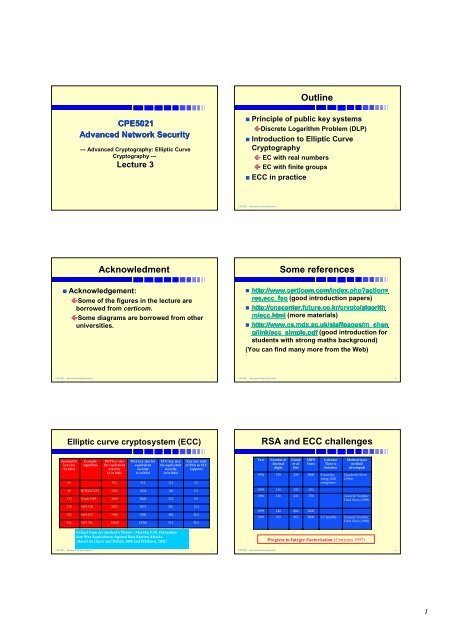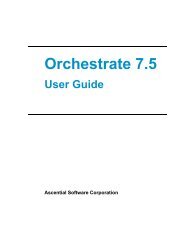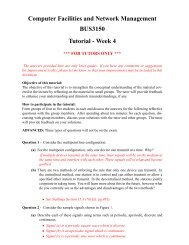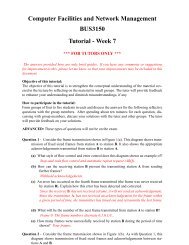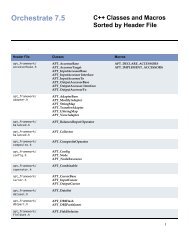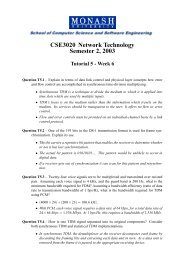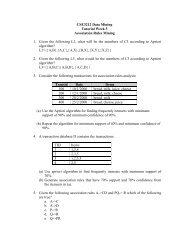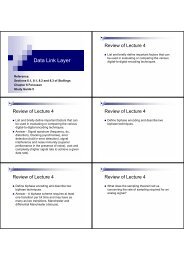Outline Acknowledment Some references RSA and ECC challenges
Outline Acknowledment Some references RSA and ECC challenges
Outline Acknowledment Some references RSA and ECC challenges
Create successful ePaper yourself
Turn your PDF publications into a flip-book with our unique Google optimized e-Paper software.
<strong>Outline</strong><br />
CPE5021<br />
Advanced Network Security<br />
--- Advanced Cryptography: Elliptic Curve<br />
Cryptography ---<br />
Lecture 3<br />
• Principle of public key systems<br />
Discrete Logarithm Problem (DLP)<br />
• Introduction to Elliptic Curve<br />
Cryptography<br />
EC with real numbers<br />
EC with finite groups<br />
• <strong>ECC</strong> in practice<br />
CPE5021 - Advanced Network Security 2<br />
<strong>Acknowledment</strong><br />
• Acknowledgement:<br />
<strong>Some</strong> of the figures in the lecture are<br />
borrowed from certicom.<br />
<strong>Some</strong> diagrams are borrowed from other<br />
universities.<br />
<strong>Some</strong> <strong>references</strong><br />
• http://www.certicom.com/index.php?action=<br />
res,ecc_faq (good introduction papers)<br />
• http://cnscenter.future.co.kr/crypto/algorith<br />
m/ecc.html (more materials)<br />
• http://www.cs.mdx.ac.uk/staffpages/m_chen<br />
g/link/ecc_simple.pdf (good introduction for<br />
students with strong maths background)<br />
(You can find many more from the Web)<br />
CPE5021 - Advanced Network Security 3<br />
CPE5021 - Advanced Network Security 4<br />
Elliptic curve cryptosystem (<strong>ECC</strong>)<br />
<strong>RSA</strong> <strong>and</strong> <strong>ECC</strong> <strong>challenges</strong><br />
Symmetric<br />
key size<br />
(in bits)<br />
56<br />
Example<br />
algorithm<br />
-<br />
DLP key size<br />
for equivalent<br />
security<br />
(p in bits)<br />
512<br />
<strong>RSA</strong> key size for<br />
equivalent<br />
security<br />
(n in bits)<br />
512<br />
<strong>ECC</strong> key size<br />
for equivalent<br />
security<br />
(n in bits)<br />
112<br />
Key size ratio<br />
of <strong>RSA</strong> to <strong>ECC</strong><br />
(approx)<br />
5:1<br />
Year<br />
1994<br />
Number of<br />
decimal<br />
digits<br />
129<br />
Numb<br />
er of<br />
bits<br />
429<br />
MIPS<br />
Years<br />
5000<br />
Calendar<br />
Time to<br />
Solution<br />
8 months,<br />
using 1600<br />
computers<br />
Method (year<br />
method<br />
developed)<br />
Quadratic Sieve<br />
(1984)<br />
80<br />
112<br />
SKIPJACK22<br />
Triple DES<br />
1024<br />
2048<br />
1024<br />
2048<br />
160<br />
224<br />
6:1<br />
9:1<br />
1995<br />
1996<br />
119<br />
130<br />
395<br />
432<br />
250<br />
750<br />
General Number<br />
Field Sieve (1989)<br />
128<br />
192<br />
256<br />
AES-128<br />
AES-192<br />
AES-256<br />
3072<br />
7680<br />
15360<br />
3072<br />
7680<br />
15360<br />
256<br />
384<br />
512<br />
12:1<br />
20:1<br />
30:1<br />
1999<br />
1999<br />
140<br />
155<br />
466<br />
512<br />
2000<br />
8000<br />
3.7 months<br />
General Number<br />
Field Sieve (1989)<br />
Extract from my student’s Thesis – Markku N.M. Pekkarinen<br />
Key Size Equivalence Against Best Known Attacks<br />
(Based on López <strong>and</strong> Dahab, 2000 <strong>and</strong> Fibíková, 2002)<br />
Progress in Integer Factorisation (Certicom 1997)<br />
CPE5021 - Advanced Network Security 5<br />
CPE5021 - Advanced Network Security 6<br />
1
Discrete Logarithm Problem (DLP)<br />
• For a group G,<br />
Given group elements,<br />
α,β<br />
find an integer x such that<br />
x<br />
β = α<br />
x is called the discrete log of to the base .<br />
- It is easy to compute<br />
β<br />
- It is hard to find x, , knowing α <strong>and</strong><br />
β<br />
β<br />
α<br />
DLP - Example<br />
• If a b = c, then log a<br />
c = b<br />
• Example:<br />
2 3 = 8 log 8 = 3<br />
2<br />
10<br />
3 = 100 log 10 1000 = 3<br />
• Computing a b <strong>and</strong> log a<br />
c are both easy for real<br />
numbers.<br />
• However, when working with field such as<br />
(Zp,mod), it is easy to calculate c = a b mod p, , but<br />
given c, a <strong>and</strong> p it is very difficult to find b.<br />
• Given an integer n it is hard to find two integers p, q<br />
such that n = p•q (factorisation<br />
problem as in <strong>RSA</strong>)<br />
CPE5021 - Advanced Network Security 7<br />
CPE5021 - Advanced Network Security 8<br />
Real Elliptic Curves<br />
Example of EC<br />
• An elliptic curve is defined by an equation<br />
in two variables x & y, with coefficients:<br />
y 2 + axy<br />
+ by y = x 3 + cx 2 + dx + e (general form)<br />
• Consider a cubic elliptic curve of form<br />
y 2 = x 3 + ax + b; where x,y,a,b<br />
are all real<br />
numbers. Eg.<br />
• y 2 = x 3 + x + 1.<br />
• y 2 = x 3 + 2x 2 + 6.<br />
CPE5021 - Advanced Network Security 9<br />
CPE5021 - Advanced Network Security 10<br />
Elliptic curve over real number<br />
• Let’s consider the equation:<br />
y 2 = x 3 + ax + b, where x, y, a <strong>and</strong> b<br />
are real numbers, where 4a 3 + 27b 2<br />
≠0 – condition for distinct single<br />
roots (smooth curve).<br />
• All (x,y) points satisfying above<br />
equation along with a infinite point O<br />
<strong>and</strong> addition operation (+), form a<br />
group. O <strong>and</strong> (+) are defined in the<br />
next slide. O is the identity of the group.<br />
EC over a group (G,+) – E(G,+)<br />
An EC over a group (G,+) is defined with the<br />
following:<br />
1. Addition: : If P <strong>and</strong> Q are distinct, <strong>and</strong> P ≠ -<br />
Q, define P+Q as follows:<br />
Draw a line through P <strong>and</strong> Q, then the line will<br />
intersect with the curve, the intersected point<br />
is denoted as –R, <strong>and</strong> define P+Q=R.<br />
2. For every P, define P + (-P)(<br />
= O<br />
3. If P=(x,0), then P+P = O , (a vertical line)<br />
Otherwise, draw a tangent line<br />
through P, the intersected point is<br />
defined as –R, then P+P =2P =R.<br />
CPE5021 - Advanced Network Security 11<br />
CPE5021 - Advanced Network Security 12<br />
2
Definition of P+Q = R<br />
Definition of P+(-P)<br />
P)<br />
CPE5021 - Advanced Network Security 13<br />
CPE5021 - Advanced Network Security 14<br />
Definition of P+P (where y!=0)<br />
Definition of P+P (where y=0)<br />
CPE5021 - Advanced Network Security 15<br />
CPE5021 - Advanced Network Security 16<br />
Elliptic Curve : An Algebraic Approach<br />
Finite Elliptic Curves on discrete Fields<br />
1. Adding distinct points P <strong>and</strong> Q (1)<br />
When P = (x(<br />
,y P P ) <strong>and</strong> Q = (x(<br />
Q ,y Q<br />
) <strong>and</strong> P≠ P Q, P ≠ -Q,<br />
P + Q = R(x R<br />
, y ) with x R R = s 2 - x P<br />
- x <strong>and</strong> y Q R = s(x P<br />
- x R<br />
) - y P<br />
where s = (y(<br />
P<br />
- y ) / (x(<br />
Q P - x Q )<br />
2. Doubling the point P (2)<br />
When y P<br />
is not O,<br />
2P = R(x R,<br />
y ) with x R R = s 2 - 2x <strong>and</strong> y P R = s(x P<br />
- x R<br />
) -y P<br />
where s = (3x P2<br />
+ a) / (2y P<br />
)<br />
3. P + (-P)(<br />
=O = (3)<br />
4. If P = (x(<br />
,y P P ) <strong>and</strong> y P<br />
=0, then P + P = 2P = O (4)<br />
• Cryptography works with finite field <strong>and</strong><br />
Elliptic curve cryptography uses curves<br />
whose variables <strong>and</strong> coefficients are finite<br />
• There are two commonly used <strong>ECC</strong> families:<br />
prime curves E p (a,b) defined over Z p<br />
• use modulo with a prime number p<br />
• efficient in software<br />
binary curves E 2m(a,b)<br />
defined over GF(2 n )<br />
• use polynomials with binary coefficients<br />
• efficient in hardware<br />
CPE5021 - Advanced Network Security 17<br />
CPE5021 - Advanced Network Security 18<br />
3
Elliptic Curve Groups over Z p<br />
• (Zp,, mod) = {0,1,…,p-1} 1} is a group<br />
Where p is a prime number<br />
• Define the elliptic curve<br />
y 2 = x 3 + ax x + b mod p<br />
Where<br />
a <strong>and</strong> b are in Zp, , <strong>and</strong> x, y are also<br />
in Zp.<br />
(4a<br />
3 + 27b 2 (mod p)) ≠ 0 .<br />
EC over (Zp(<br />
Zp, , mod)- examples<br />
• p=11, Zp=Z<br />
11 . y 2 = x 3 + x + 6 (mod 11)<br />
E(Z 11 , mod) = {(2,4),(2,7),{<br />
(3,5),(3,6), (5,2),(5,9), (7,2),(7,9),<br />
(8,3),(8,8), (10,2),(10,9)}<br />
• p=23, Zp=Z<br />
23 . y 2 = x 3 + x (mod 23)<br />
E(Z 23 , mod) = {(0,0), (1,5), (1,18), (9,5), (9,18), (11,10), (11,13),<br />
(13,5), (13,18), (15,3), (15,20), (16,8), (16,15), (17,10), (17,13),<br />
13),<br />
(18,10), (18,13) (19,1),(19,22), (20,4), (20,19), (21,6), (21,17)}<br />
• p=23, Zp=Z<br />
23 . y 2 = x 3 + x + 1 (mod 23)<br />
E(Z 23 ,mod) = { (0,1), (0,22), (1,7), (1,16), (3,10), (3,13), (4,0), (5,4),(<br />
(5,19), (6,4), (6,19), (7,11), (7,12), (9,7), (9,16), (11,3), (11,20), 1,20), (12,4),<br />
(12,19), (13,7), (13,16), (17,3), (17,20), (18,3), (18,20), (19,5), (19,18)}<br />
CPE5021 - Advanced Network Security 19<br />
CPE5021 - Advanced Network Security 20<br />
y 2 = x 3 + x mod 23<br />
Operations on E(Z 11 ,mod)<br />
• Consider the E(Z 11 ,mod):<br />
Let P <strong>and</strong> Q on E(Z 11 ,mod)<br />
1. P = (10,2) <strong>and</strong> Q= (5,2) then<br />
then P + Q = (10,2) +<br />
(5,2) = (7,9).<br />
2. P = (2,7); P + P = (5,2).<br />
3. P = (2,7); -P P = (2,-7); P + -P P =?<br />
CPE5021 - Advanced Network Security 21<br />
CPE5021 - Advanced Network Security 22<br />
Elliptic Curve Cryptography (ECDLP)<br />
• Assume that we are working with E(Z , mod)<br />
p<br />
Let Q <strong>and</strong> P be on E(Z p , mod); <strong>and</strong> 1 < k < p-1p<br />
• Define a hard problem which is equivalent<br />
to the DLP: Q=kP<br />
It is “easy” to compute Q given k <strong>and</strong> P<br />
but it is “hard” to find k given Q,P<br />
known as the elliptic curve logarithm problem<br />
(ECDLP)<br />
<strong>ECC</strong> in Practice – simple method<br />
• Suppose A wants to send a message m to B<br />
using EC over group (G,+) = {0, ..n-1} with<br />
generator g<br />
Key generation: B selects a r<strong>and</strong>om integer B s<br />
from the interval [1, n-1] n<br />
as private key <strong>and</strong><br />
publish B p = B s g as B’s public key<br />
Encryption: A selects a r<strong>and</strong>om integer A s as A’s<br />
secrete key <strong>and</strong> send to B: (A(<br />
s g, A s B p + m) to B<br />
as ciphertext (A s g = A p is A’s public key).<br />
B B decrypts the message by computing<br />
m + A s B p - B s (A s g) ) = m + A s B s g - B s A s g = m<br />
CPE5021 - Advanced Network Security 23<br />
CPE5021 - Advanced Network Security 24<br />
4
E(Z 11 ,mod) with generator<br />
• y 2 = x3 +x+6 mod 11.<br />
E( E(Z 11 ,mod) = {(2,4),(2,7),{<br />
(3,5),(3,6),<br />
(5,2),(5,9), (7,2),(7,9), (8,3),(8,8),<br />
(10,2),(10,9)}<br />
E(Z 11 ,mod) with generator<br />
• Let’s select g =(2,7) as a generator.<br />
• Compute 2g, , 3g, … as using the<br />
following:<br />
2P = R(x R,<br />
y ) with x R R = s2s<br />
- 2x <strong>and</strong> y P R = s(x P<br />
- x R<br />
) -y P<br />
where s = (3x 2 P<br />
+ a) / (2y P<br />
)<br />
{g=(2,7), 2g=(5,2), 3g=(8,3), 4g=(10,2)<br />
5g=(3,6), 6g=(7,9), 7g=(7,2), 8g=(3,5)<br />
9g=(10,9), 10g=(8,8),11g=(5,9),12g=(2,4)}<br />
CPE5021 - Advanced Network Security 25<br />
CPE5021 - Advanced Network Security 26<br />
<strong>ECC</strong> example on E(Z 11 ,mod)<br />
y 2 = x3 +x+6 mod 11<br />
<strong>ECC</strong> system (general approach)<br />
• Suppose message is m =(3,6) (a point on E).<br />
• B selects a r<strong>and</strong>om B s =3, then send B p to A;<br />
• B p = B s g = 3g = g+g+g = (8,3); where g =(2,7)<br />
• A selects a r<strong>and</strong>om number <strong>and</strong> generates A’s public<br />
key, let’s s say 2. A s = 2; A p = A s g = 2g = g+g = (5,2).<br />
A A encrypts the message: (A s g, A s B p + m) = ((5,2), 2(8,3) +<br />
(3,6)) = ((5,2), (7,9) + (3,6)) = ((5,2), (5,9)).<br />
• B decrypts the cipher by first computing A s gB s<br />
A s gB s = 3(5,2) = (5,2) + (5,2) + (5,2) = (10,2) + (5,2)<br />
= (7,9);<br />
A s B p + m – A s gB s = (5,9) – (7,9) = (5,9) + (7,-9) = (5,9) +<br />
(7,2) = (3,6)<br />
• General steps to construct an EC<br />
cryptosystem<br />
1. Selects an underlying field F<br />
2. Selects a representation for the elements of F<br />
3. Implementing arithmetic operations in F<br />
4. Selecting an appropriate EC over F to form E(F)<br />
5. Implementing EC operations in group E(F)<br />
6. Choose a protocol<br />
7. Implement <strong>ECC</strong> based on the chosen protocol.<br />
CPE5021 - Advanced Network Security 27<br />
CPE5021 - Advanced Network Security 28<br />
Diffie-Hellman<br />
Key Exchange Protocol<br />
Diffie Hellman over <strong>ECC</strong><br />
Alice<br />
Generates SA<br />
Computes PA = SAG<br />
Computes P1 = SA PB<br />
Both know G<br />
Sends PA<br />
Sends PB<br />
If P1 <strong>and</strong> P2 are the<br />
same, use either P1<br />
or P2 as the shared<br />
secret key<br />
Bob<br />
Generates SA<br />
Computes PB = SBG<br />
Computes P2 = SB PA<br />
• Alice chooses a r<strong>and</strong>om a <strong>and</strong> compute aP<br />
∈ E<br />
• Bob chooses a r<strong>and</strong>om b <strong>and</strong> compute bP ∈<br />
E<br />
• Alice <strong>and</strong> Bob exchange the computed<br />
values<br />
• Alice, from bP <strong>and</strong> a can compute S = abP<br />
• Bob, from aP <strong>and</strong> b can compute S = abP<br />
CPE5021 - Advanced Network Security 30<br />
5
Simple implementation of <strong>ECC</strong><br />
Embedding plaintext messages as<br />
points on an Elliptic Curve<br />
• Simple steps to construct an EC cryptosystem<br />
1. Select an underlying field F <strong>and</strong> generate a r<strong>and</strong>om curve (e.g(<br />
e.g: y 2 = x 3<br />
+ ax x + b ) – store values of a <strong>and</strong> b<br />
(should declare data structures to store curve <strong>and</strong> point t parameters<br />
prior this)<br />
1. Find the base point g (generator) as public point (Every one knows this<br />
point)<br />
2. Compute share secret key using Diffie Hellman over <strong>ECC</strong><br />
3. Compute public keys:<br />
1. Alice chooses a r<strong>and</strong>om as her secret key A s <strong>and</strong> computes her public key<br />
A p = A s g<br />
2. Bob chooses a r<strong>and</strong>om B s <strong>and</strong> computes his public key B p = B s g<br />
(Both Alice <strong>and</strong> Bob can now compute shared key B s A s g)<br />
Embed message m onto a point, M(x,y), of the curve using Koblitz’s<br />
method (see next slide)<br />
Encrypt <strong>and</strong> decrypt<br />
1. Alice encrypts the message M(x,y): (A(<br />
p , A s B p + M) <strong>and</strong> sends it to Bob.<br />
2. Bob decrypts the message by computing A p B s <strong>and</strong> then<br />
M + A s B p - A p B s = M + A s B s g - A s gB s = M<br />
CPE5021 - Advanced Network Security 31<br />
• In order to build an <strong>ECC</strong>, there must be an<br />
accurate <strong>and</strong> efficient way for embedding a<br />
ciphertext message on an EC.<br />
There is no known deterministic algorithm for<br />
embedding message units as points on an<br />
elliptic curve.<br />
However, there is a probabilistic method that can<br />
be used for embedding message units as points<br />
on an elliptic curve.<br />
See<br />
Koblitz’s proposal of representing a<br />
message unit as a point on an EC.<br />
CPE5021 - Advanced Network Security 32<br />
Embed a message m<br />
Remarks<br />
• Suppose p is prime with p mod 4 = 3<br />
• Pick k so that 1/2 k is small<br />
• Let m be the message <strong>and</strong> allows m < (p-k)/k(<br />
• For j=0, …, k-1k<br />
• Set x j = m*k + j ; w j = x 3 + a x j + b; z j =<br />
w ((p+1)/4)<br />
j<br />
• If (z(<br />
2 = w j ) then (x j , z j ) is the point to encode<br />
m<br />
• If no j works then FAIL with Prob.


